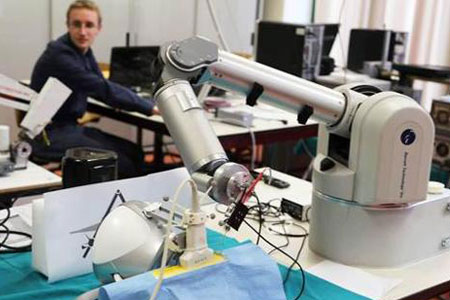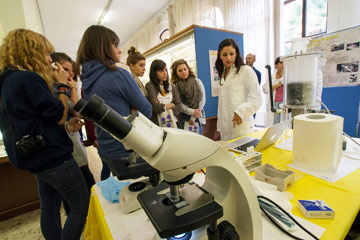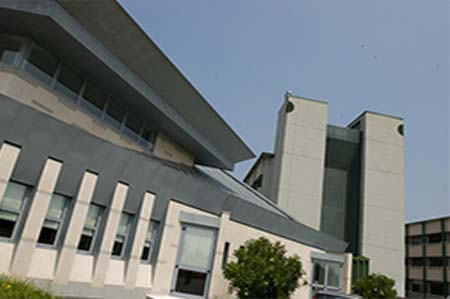|
Life and medical sciences
standard compliant
ACM 2012
|
| Algorithms for Bioinformatics |
Ferdinando Cicalese
|
Our research focuses on design of algorithms for the management and analysis of large scale biological data (e.g. -omics data of different types). Our research is driven by the idea that modern data sciences can contribute significantly to address important questions in life sciences. Algorithms from the fields of search theory (group testing), active learning, and data mining (particularly in sequences and networks), as well as, information theoretic approaches based on entropic analysis, can be used to support the causal understanding, diagnosis and prognosis of complex diseases. |
| Algorithmic bioinformatics |
Zsuzsanna Liptak
|
We develop algorithms for discrete problems arising from computational biology, among these: algorithms for mass spectrometry data interpretation, clustering of transcriptomic data, non-alignment based sequence comparison. |
| Bioinformatics and Computational Biology |
Manuele Bicego
|
Design and testing of Pattern Recognition and Machine Learning techniques for the analysis and understanding of biological data. In particular the main focus in on designing solutions for the analysis of "counting data" - namely data which express the level of presence of entities (e.g. gene expression data, or proteomics data) - using probabilistic graphical models like topic models. The main goal is to devise highly interpretable solutions, being interpretability of methods and solutions the most stringent need in nowadays bioinformatics research. |
| Bioinformatics and Natural Computing |
Giuditta Franco
Rosalba Giugno
Vincenzo Manca
|
Our research is mainly focused on the following topics: 1) Discrete and algorithmic analyses of biological dynamics (metabolism and replication, and their interplay in cellular processes); 2) Informational and computational analysis of genomes (genomic dictionaries, genomic indexes, genomic distributions of specific parameters, genome representations, genome synthesis and reconstruction from dictionaries). In these research areas, theories and algorithms are investigated and software packages are developed for computational experiments and analyses. |
| Biological network dynamics |
Giuditta Franco
|
Design and analysis of data-driven computational models, for both metabolic and immunological dynamics, based on grammars ruled by state functions. Biological network dynamical properties are investigated in terms of discrete mathematics and model simulation. Membrane and metabolic computing for biological modeling. Genetic network investigation based on computational genomics studies. |
| Computational genomics and DNA computing |
Giuditta Franco
|
Investigation and classification of genomic sequences by means of information theory based methods. Design and analysis of both bio-inspired and molecular algorithms, along with their lab implementation. |
| Neuroimaging |
Umberto Castellani
Alessandro Daducci
|
The main activity is in the field of neuroimaging, including structural (diffusion MRI) and functional (EEG, fNIRS, functional MRI) imaging as well as perceptual analysis through cognitive science methods. The goal is to gain an holistic view of human brain when inspected in specific conditions by the integration of multi-modal multi-scale probing and modeling. In addition, advanced computer vision and pattern recognition methods are employed for designing numerical biomarkers for the characterization of healthy and pathological conditions. |
| Health Information Systems |
Carlo Combi
Barbara Oliboni
|
Main research interests to the management of clinical information in medical records and to the management of clinical processes/guidelines. More precisely main topics are:
- temporal information systems in medicine;
- temporal workflow systems in medicine and healthcare: modeling issues and architectures;
- temporal and multimedia clinical databases;
- temporal data warehouses and temporal data mining for health/clinical knowledge discovery;
- visualizing temporal and multimedia clinical data;
- Web-based access to clinical information. |
| Systems Biology, Computational Network Biology |
Rosalba Giugno
|
Design of algorithms and methods to understand biological systems using data mining and bioinformatics techniques. The focus is on biological network modeling, perturbation and analysis; classification of phenotypes by coding and non-coding expression profiles; drug synergy and mechanism of action by drug target/off-target/combination prediction. |
|
Operations research
standard compliant
ACM 2012
|
| Operations research |
Romeo Rizzi
|
Operations research is a discipline that deals with the application of advanced analytical methods to help make better decisions. The terms management science and decision science are sometimes used as more modern-sounding synonyms. Employing techniques from other mathematical sciences, such as mathematical modeling, statistical analysis, and mathematical optimization, operations research arrives at optimal or near-optimal solutions to complex decision-making problems. Operations Research is often concerned with determining the maximum (of profit, performance, or yield) or minimum (of loss, risk, or cost) of some real-world objective. Originating in military efforts before World War II, its techniques have grown to concern problems in a variety of industries. Besides its applications in industry and in management, Operations Research is at the very junction of mathematics and economics. Operations research embodies lots of deep results and theory but, at the same time, it is the archetype of applied mathematics. In Verona, we draw applications of the tools and methodologies of operations research to computational biology. More generally, we actively work in combinatorial optimization and contribute to algorithmic graph theory. We also apply and express methods and competencies of mathematical programming. In mathematics, statistics, empirical sciences, computer science, or management science, mathematical optimization (alternatively, mathematical programming) is the selection of a best element (with regard to some criteria) from some set of available alternatives. Here, optimization includes finding "best available" values of some objective function given a defined domain, including a variety of different types of objective functions and different types of domains. Optimization theory, techniques, and algorithms, comprises a large area of applied mathematics. Among the many sectors of mathematical programming, some of those represented in Verona are the following: linear programming, integer linear programming, combinatorial optimization, multiobjective optimization. |







